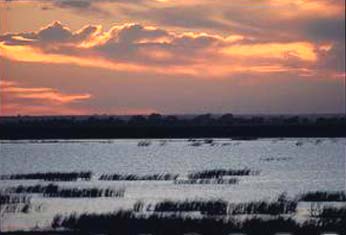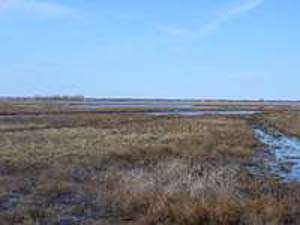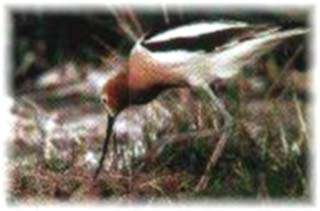Cheyenne Bottoms Wildlife Area, KS
There are 650 bird species in the United States, 417 in Kansas, and 320 in Cheyenne Bottoms! Besides birds, there are 23 species of mammals 19 species of reptiles and nine species of amphibians.
Cheyenne Bottoms and nearby Quivira National Wildlife Area are also half-way down the central flyaway for migrating birds. Out of more than 200 stopover areas, Cheyenne Bottoms attracts 45 percent of North American Shorebirds. Both refuges host myriads of ducks and thousands of sandhill cranes on the way to their staging area along the Platte River in Nebraska.
During these seasons is an excellent time to visit since each refuge swells to accommodate between 500,000 and 600,000 birds. Photographers and naturalists enjoy Cheyenne Bottoms and Quivira because they are not sensationalized. They are however, listed first and second in the Dynamic Dozen list of WATCHING KANSAS WILDLIFE/A GUIDE TO 101 SITES by Bob Gress and George Potts, University Press of Kansas, 1993.
Of the 41,000 acre elliptical shaped basinlike lowlands six miles northeast of Great Bend, the Kansas Department of Wildlife an Parks operates 19,857 acres as a wildlife management area. It is considered the largest marsh in the interior of the United States and has been designated a "Wetland of International Importance."
This is the most important ecosystem in Kansas and the most important migration point for shorebirds in North America. From 45% to 90% of various shorebirds, geese and duck species stop at Cheyenne Bottoms. Over 100 species nest in the area and 64 species are permanent residents. "All wildlife watchers should make an annual pilgrimage to Cheyenne Bottoms..." says Bob Gress.



 The fall shorebird migration can begin as early as July and extend will into September and October. Because of this, the bird numbers are not as impressive as the spring movement since the birds do not achieve as great a number at any one time. The peak period for duck viewing in the fall occurs early to mid-October. Most wading birds remain on the area until the marsh freezes. This is especially true for the great blue heron. Whooping cranes, which migrate from Texas to Northern Canada and back, are most apt to stop at Cheyenne Bottoms in late October into early November. Bald eagles winter on the area and are present from as early as November to as late as March. A checklist of birds found on the area and the seasons they are present is available at the area office and the information signs at the main entrances.
The fall shorebird migration can begin as early as July and extend will into September and October. Because of this, the bird numbers are not as impressive as the spring movement since the birds do not achieve as great a number at any one time. The peak period for duck viewing in the fall occurs early to mid-October. Most wading birds remain on the area until the marsh freezes. This is especially true for the great blue heron. Whooping cranes, which migrate from Texas to Northern Canada and back, are most apt to stop at Cheyenne Bottoms in late October into early November. Bald eagles winter on the area and are present from as early as November to as late as March. A checklist of birds found on the area and the seasons they are present is available at the area office and the information signs at the main entrances.